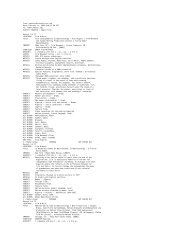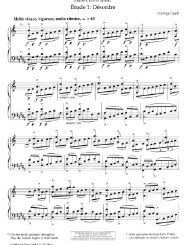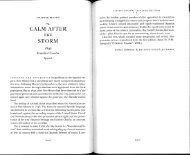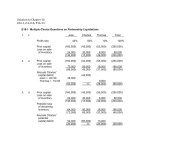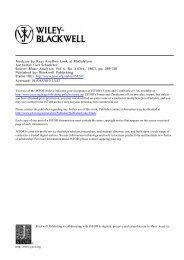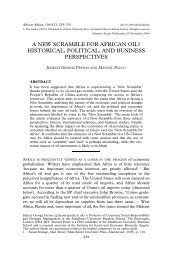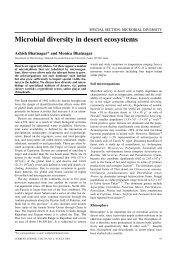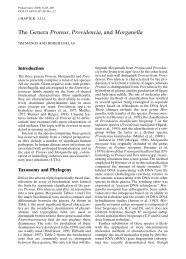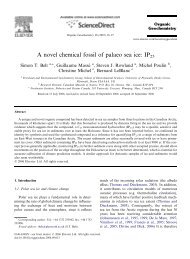The Genus Serratia
The Genus Serratia
The Genus Serratia
Create successful ePaper yourself
Turn your PDF publications into a flip-book with our unique Google optimized e-Paper software.
226 F. Grimont and P.A.D. Grimont CHAPTER 3.3.11<br />
latter hemolysis pattern was produced only by S.<br />
marcescens biogroup A4.<br />
<strong>The</strong> cell-bound hemolysin has been studied<br />
and direct contact between erythrocytes and S.<br />
marcescens cells has been demonstrated (Braun<br />
et al., 1985). <strong>The</strong> lysis of erythrocytes requires<br />
actively metabolizing bacteria and does not need<br />
calcium ions. A 7.3-kilobase-pair chromosomal<br />
fragment encoding the hemolytic activity has<br />
been cloned in Escherichia coli and sequenced<br />
(Poole et al., 1988). Two open reading frames<br />
designated shlA and shlB have been observed.<br />
<strong>The</strong> hemolysin protein (molecular weight<br />
165,056) is encoded by shlA, and the product of<br />
shlB somehow activates shlA. Protein shlA integrates<br />
into the erythrocyte membrane and causes<br />
osmotic lysis through channel formation (Schiebel<br />
and Braun, 1989). When an E. coli strain<br />
carrying the <strong>Serratia</strong> hemolysin gene was compared<br />
to the isogenic strain without such a gene<br />
in an experimental rat model (10 7 CFU/ml<br />
injected via urethra into the bladder), the<br />
strain carrying the hemolysin gene colonized the<br />
urinary tract more and led to a stronger inflammatory<br />
response compared to the hemolysinnegative<br />
strain (Marre et al., 1989).<br />
A capsulated <strong>Serratia</strong> strain injected in the<br />
peritoneal cavity of the mouse multiplied and<br />
killed the mouse whereas an uncapsulated variant<br />
was avirulent (Ohshima et al., 1984).<br />
Traub (1983) has shown that antibodies<br />
directed against O antigens of challenge strains<br />
afford passive protection in mice. <strong>The</strong> predominance<br />
of the O6 and O14 serotypes of S. marcescens<br />
in infections, the surface localization of<br />
LPS and its masking of other antigens suggests<br />
that LPS is a prime candidate for exploitation as<br />
a protective antigen in a vaccine against S.<br />
marcescens (Jessop, 1985).<br />
Traub and Fukushima (1979a) classified S.<br />
marcescens strains into three categories with<br />
respect to their serum susceptibility. In solutions<br />
with 80% (vol/vol) of fresh serum, 88% of strains<br />
were found to be “delayed serum-sensitive” i.e.,<br />
they were killed after a few hours exposure; 6%<br />
of strains were “promptly serum-sensitive” i.e.,<br />
they were killed within a matter of minutes; and<br />
6% of strains resisted an overnight exposure to<br />
serum. <strong>The</strong> delayed serum-sensitive strains were<br />
shown to be killed via the activation of the alternative<br />
pathway of the human complement system<br />
since killing was unaffected by inhibition of<br />
the classical pathway (Traub and Kleber, 1976).<br />
Conversely, promptly serum-sensitive strains<br />
were killed in a delayed fashion when the classical<br />
pathway was inhibited (Traub and Kleber,<br />
1976). Depletion of fresh human serum of C3<br />
with hydrazine hydrate completely abolished the<br />
bacterial activity against both promptly serumsensitive<br />
and delayed serum-sensitive strains<br />
(Traub and Fukushima, 1979a). Complement is<br />
of prime importance with respect to efficient<br />
opsonization and subsequent phagocytic killing<br />
by human peripheral blood granulocytes (Traub,<br />
1982). In an intraperitoneal mouse model, treatment<br />
of animals with cyclophosphamide (generating<br />
a leukopenia) or zymosan (depletion of<br />
complement) did not increase susceptibility to S.<br />
marcescens. A combination of both treatments<br />
was necessary to significantly raise susceptibility<br />
to S. marcescens (Traub et al., 1983).<br />
Crude culture filtrates have been shown to<br />
produce dermal hemorrhage after intradermal<br />
inoculation (Liu, 1961), corneal damage (Kreger<br />
and Griffin, 1975), and endophthalmitis after<br />
intravitreal injection (Salceda et al., 1973). <strong>The</strong>se<br />
are due to one or more extracellular proteases<br />
produced by S. marcescens. Up to four proteases<br />
were purified (Lyerly and Kreger, 1979; Matsumoto<br />
et al., 1984)—two metalloproteases of 56<br />
and 60 KDa and two thiol proteases of 73 KDa.<br />
<strong>The</strong>se proteases play a prominent role in<br />
the pathogenesis of experimental pneumonia<br />
(Lyerly and Kreger, 1983) and keratitis (Lyerly<br />
et al., 1981). Most studies focused on the 56-KDa<br />
protease. Protease(s) were shown to cause: 1)<br />
liquefactive necrosis of the cornea (Kamata et<br />
al., 1985); 2) inactivation of five major proteinase<br />
inhibitors including α1-proteinase inhibitor<br />
(Virca et al., 1982), α 2-macroglobulin, Cl inhibitor,<br />
α 2-antiplasmin, and antithrombin III (Molla<br />
et al., 1989), which participate in regulating various<br />
cascade mechanisms (fibrinolysis and clotting<br />
cascade, complement system, inflammatory<br />
response); 3) degradation of immunoglobulins G<br />
and A, fibronectin, and other serum proteins<br />
(Molla et al., 1986; Traub and Bauer, 1985); 4) a<br />
potent toxic effect of fibroblasts that was mediated<br />
by internalization of a proteinase-α2-macroglobulin<br />
complex via the α 2-macroglobulin<br />
receptor, followed by regeneration of the proteinase<br />
activity in the cell (Maeda et al., 1987);<br />
5) activation of the Hageman factor-kallikrein<br />
system generating kinin, which leads to<br />
enhanced vascular permeability (Matsumoto et<br />
al., 1984); and 6) cleavage of human C3 and C5<br />
to yield leukotactic fragments (Ward et al.,<br />
1973).<br />
Although resistance plasmids probably play<br />
no role in the virulence of S. marcescens in experimental<br />
models (Traub et al., 1983), multiple<br />
drug resistance may affect the course and prognosis<br />
of infections.<br />
Non-pigmented strains of S. marcescens are<br />
generally more resistant to antibiotics than<br />
pigmented strains because they often harbor<br />
resistance plasmids. Environmental strains of S.<br />
marcescens or strains isolated before the antibiotic<br />
era are resistant to colistin, cephalothin,<br />
ampicillin (low level of resistance), tetracycline,



